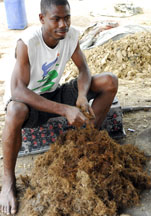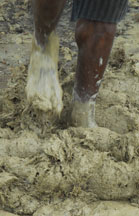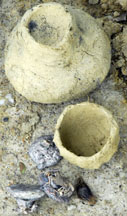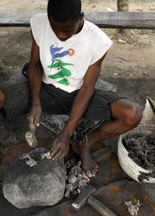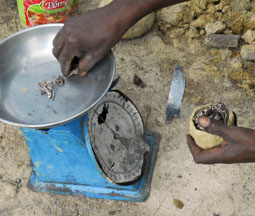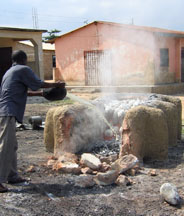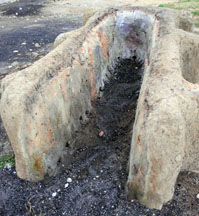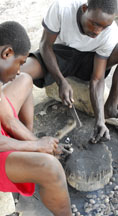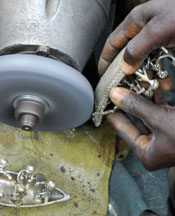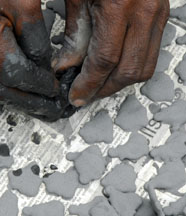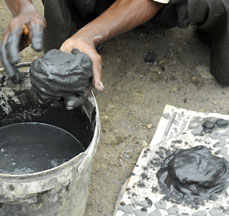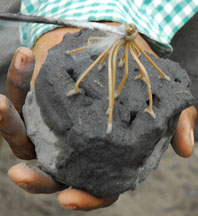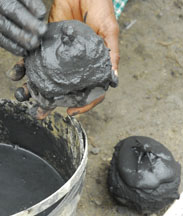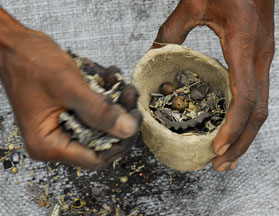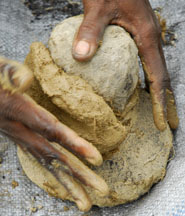Two methods of lost wax casting are done in Krofofrom. Both techniques begin with a bees wax model, but the method of filling the mold with metal differs. A wax model is made, it is covered with special mixtures to create a mold, the wax is melted out of the mold, then the cavity is filled with molten metal. The first method is demonstrated in Sokoban Krofrom (Krofofrom) by craftsmen at Providence Creation, P.O. Box 11592, Kumasi, Ghana. Telephone: 0244-524998 and 0243-818557. Email: ponsahgh@Ghanayahoo.com. |
||||
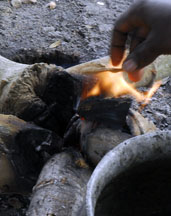 |
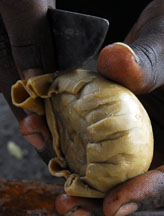 |
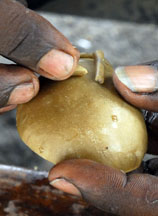 |
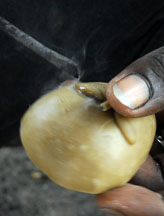 |
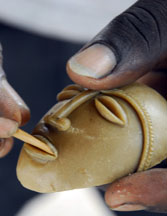 |
| To make the model, bees wax is softened in fire. | Then the wax is pressed over a mold, and cut. | More wax is added to create the details. | They are melted with a hot iron to bond them. | Features are sculpted with a wood tool. |
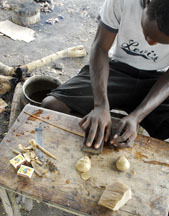 |
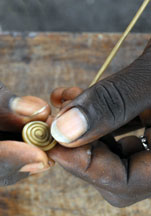 |
 |
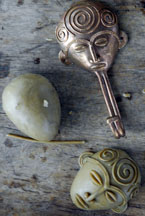 |
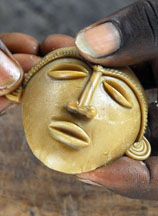 |
| A wax thread is rolled out on a table, spiraled, cut in half, then pressed onto the face to form the ears. | ||||
| A new quicker method a forming wax models utilizes cement molds to help produce flat, textured pieces. | |||
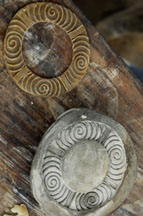 |
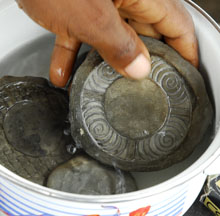 |
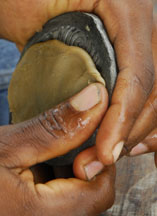 |
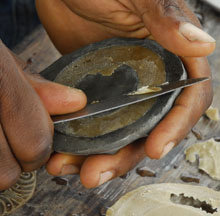 |
| The molds are soaked in water to that the bees wax won't stick. | Warm wax is pressed into the wet mold. | The excess wax is immediately cut away. | |
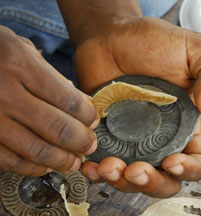 |
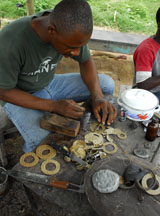 |
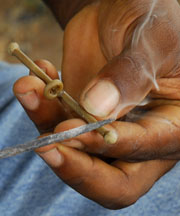 |
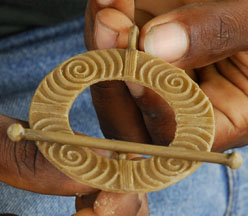 |
| The wax is carefully removed. | This other part of the buckle is fabricated. | Voila! The finished wax buckle. | |
| The next step of the process is to make a mold. | |||
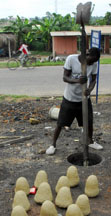 |
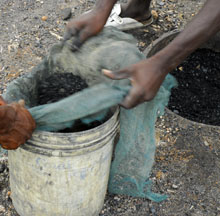 |
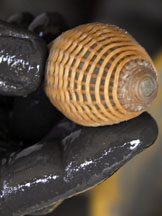 |
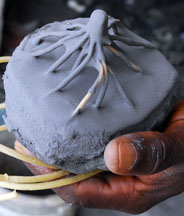 |
| Charcoal is pulverized, sifted, then mixed with water and clay to form a fine slurry that will preserve fine details. The wax models are dipped into it, bundled together so that several may be cast at once, then covered with more slurry. The wax rods (gates) will serve as channels for the molten metal. | |||
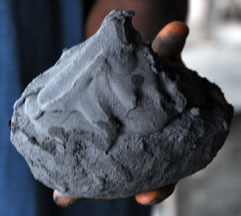 |
|
|
|
|
A thicker slurry covers everything except the top of the wax. |
Palm fiber is separated, mixed with clay, then sand is added to the mixture to form the outside of the mold. |
||
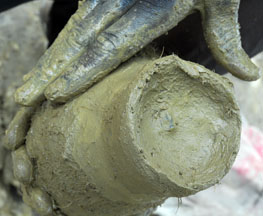 |
|
|
|
|
The fiber and clay mixture covers the black mold and is used to make a bowl-shaped top and a crucible. |
Scrap metal from earlier castings is cut apart, weighed, and then put into the crucible. |
||
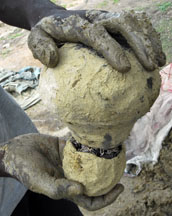 |
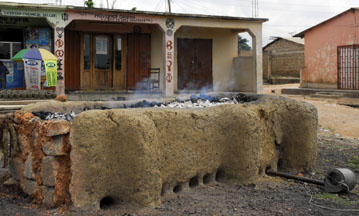 |
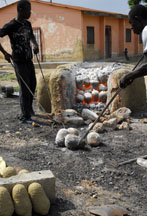 |
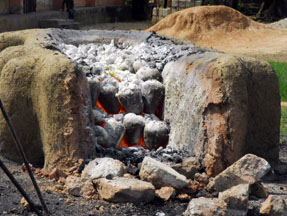 |
| The crucible is then attached to the mold with more clay and allowed to dry for a few days. | The dry molds are placed (with the metal side down) into a kiln and covered with a thick layer of charcoal. An electric blower is moved from hole to hole to gradually elevate the temperature. The wax will burn out and the metal will heat to a liquid. | After a few hours, the molds are removed, then turned over so that the metal will flow into the cavity. | |
|
|
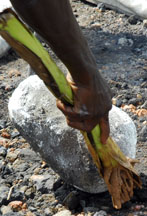 |
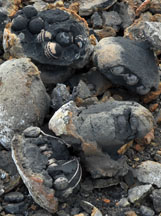 |
| Water is occasionally poured over the fire to cool the coals so that the molds that are deep in the kiln may be more easily removed with tongs. The empty kiln awaits the next firing. | A banana stem dipped in wet clay cools and hardens the metal to stop it from leaking out of a crack. | After cooling, the molds are broken open; metal has taken the place of the wax. | |
|
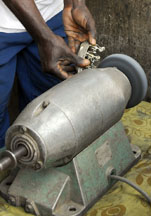 |
|
 |
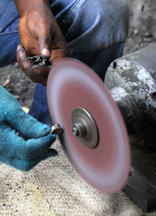 |
| After cutting off the gates with wire cutters, the burnt black core is removed. | George Owusu removes rough spots on the casting with an electric grinder. |
The side and edge of an abrasive cut-off wheel is also used to smooth the metal surface. |
||
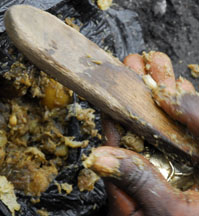 |
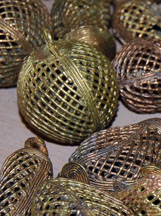 |
| The pieces are then polished with soft lemons and a wire brush. | The result is amazing! |
| The mold making process can be seen in more detail below. Unfortunately, I misplaced the name of the demonstrator, but he works for Mr. John K. Dapaah of Japad Brass Enterprise in Krofofrom, Ghana, Telephone: 0244-613157 and 0244-226605. | |||
|
|
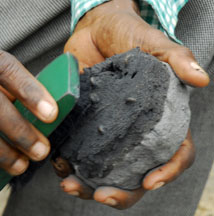 |
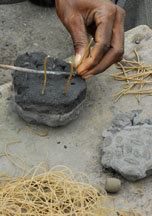 |
| Wax models are dipped into a slurry of water, clay, and fine charcoal, then dried. The pieces are next dipped into a coarser slurry and bundled together and left to dry. | A wet brush scrubs off the top of the bundle to reveal tiny parts of each embedded clay model. | Wax threads are fused to the top of each model to channel the metal during casting. | |
|
|
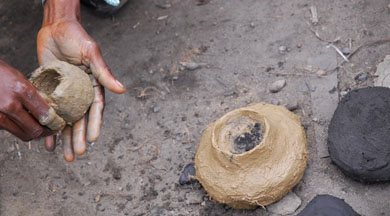 |
| The top of the threads are joined together. | The molds are then dipped into a coarse slurry and left to dry. | The dry mold is then covered with a mixture of clay, sand, and palm fiber. A crucible is made from the same mixture and both pieces are left to dry. |
|
|
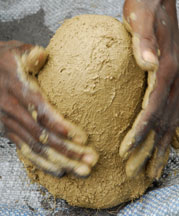 |
| The dry crucible is filled with clean scrap metal from previous castings. | The opening of the crucible is joined to the top of the mold, then both pieces are covered with the clay fiber mixture, then left to dry completely. | |
The other method of casting begins the same way at Mr. Afriyie's Gee Creation (P.O. Box X 397 F. N. T. Ksi., Kumasi, Ghana. Telephone: 0244-791914 and 0242-238487), but metal is heated separately, then poured into the molds. |
||||
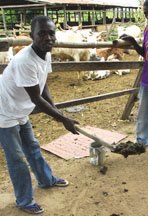 |
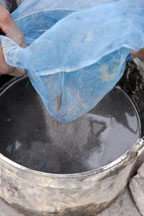 |
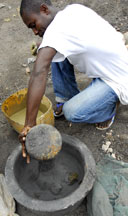 |
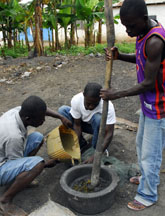 |
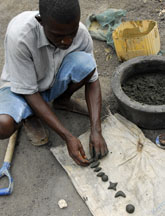 |
| Hollow beads use a core to keep the metal from filling the center of the bead. To make the core mixture, fresh cow dung is collected, the dung is covered with sifted, powdered charcoal and a clay slurry (clay mixed with water). Large pieces are smashed with a wooden pounder before it is mixed by hand to remove all the lumps. | The cores are shaped, then left to dry in the sun. | |||
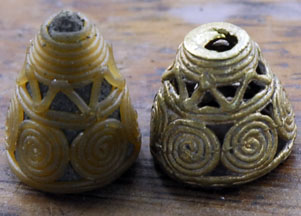 |
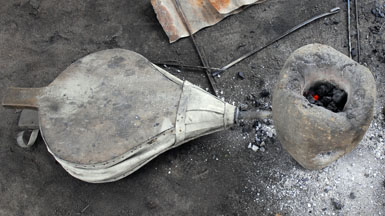 |
| A hollow bead is made by covering the core with wax threads. | The wax is heated over a small clay stove. |
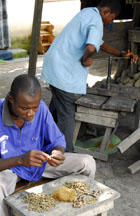 |
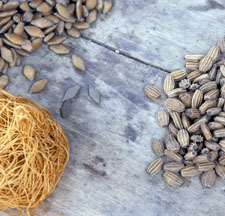 |
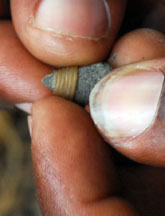 |
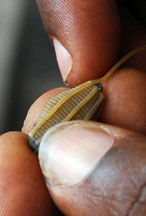 |
| The wax threads are made by pushing soft bees wax through an extruder (seen in the background). | The core is covered with extruded wax threads. | ||
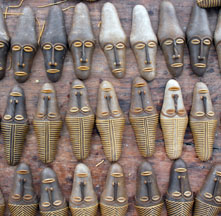 |
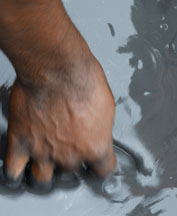 |
 |
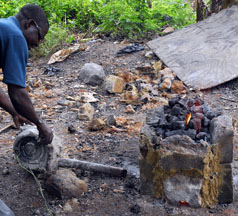 |
| As with the first method, the wax models are dipped into a slurry of water, clay and charcoal, bundled together, covered with more slurry, then covered with a coarser clay mixed with palm fiber. | Metal is placed in a crucible, then covered with charcoal. An electric blower helps raise the temperature. | ||
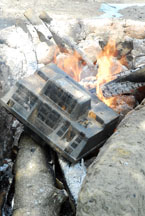 |
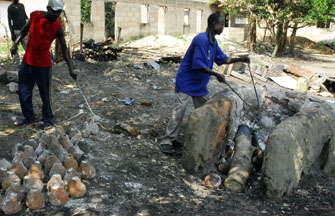 |
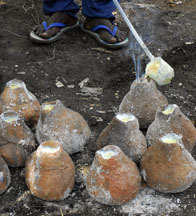 |
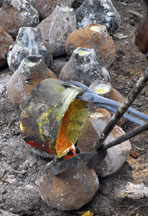 |
| The molds are placed top-down into a kiln, then heated for a few hours with wood until the wax melts out. Scrap plastic is thrown onto the fire right before casting to increase the temperature of the fire. The molds are then removed, turned upright on the ground, and filled with molten metal (brass with a little bit of aluminum). It's ready to cast when blue smoke rises from the molten metal. | The last drop of metal is poured from the crucible (a recycled refrigerator motor housing). | ||
